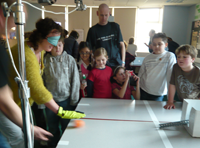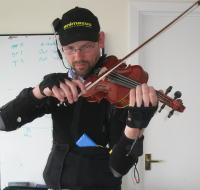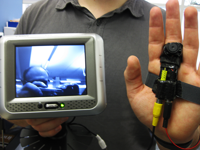Building novel augmentation devices to explore sensory, bodily and cognitive extension
The e-sense project is funded by an AHRC speculative research grant and runs from October 2008 - March 2010. In this interdisciplinary research, philosophy and art combine with various flavours of computing: ubiquitous; wearable; and physical.
We are initially rapidly prototyping a range of sensory augmentation devices including:
- a minimal tactile vision sensory substitution (TVSS) system;
- MusicJacket - a system for training novice violin players using motion capture and vibrotactile feedback;
- a Third Eye worn as a ring;
- Haptic Drum Kit - a system for teaching drummers polyphonic rhythms;
- Locusts - augmenting a multitouch table with vibrotactile feedback to enhance workspace awareness.
Philosophical analysis and artistic exploration inform our design process and user studies of the resulting augmentation devices will reciprocally feedback into these two disciplines.
News
The Extended Mind in Theory and Applications, ZIF, 23-25 November, Bielefeld, Germany.
Andy Clark and Jon Bird are invited speakers at this interdisciplinary event.
Experimentality, 19-20 November, Lancaster
Jon Bird is an invited speaker at the 'Experiment as Event in the Arts and Sciences Workshop at Lancaster University. This is part of the Institute of Advanced Studies Annual Research Programme, which this year is concerned with 'Experimentality'.
Skin Vision Demonstration at HCI 2009
Jon Bird and Paul Marshall gave a demonstration of the minimal tactile vision sensory substitution system at the Open House Festival of Technology at HCI 2009. The demo was very popular and covered by the BBC and Usability News.
Best Technology Paper at HCI 2009
Our paper on the development of the minimal tactile vision sensory substitution system was awarded the archival highlights prize for best technology paper.
Bird, J., Marshall, P. and Rogers, Y. (2009) Low-Fi Skin Vision: A Case Study in Rapid Prototyping a Sensory Substitution System. Proceedings of HCI, 55-64.
![]() PDF
PDF






